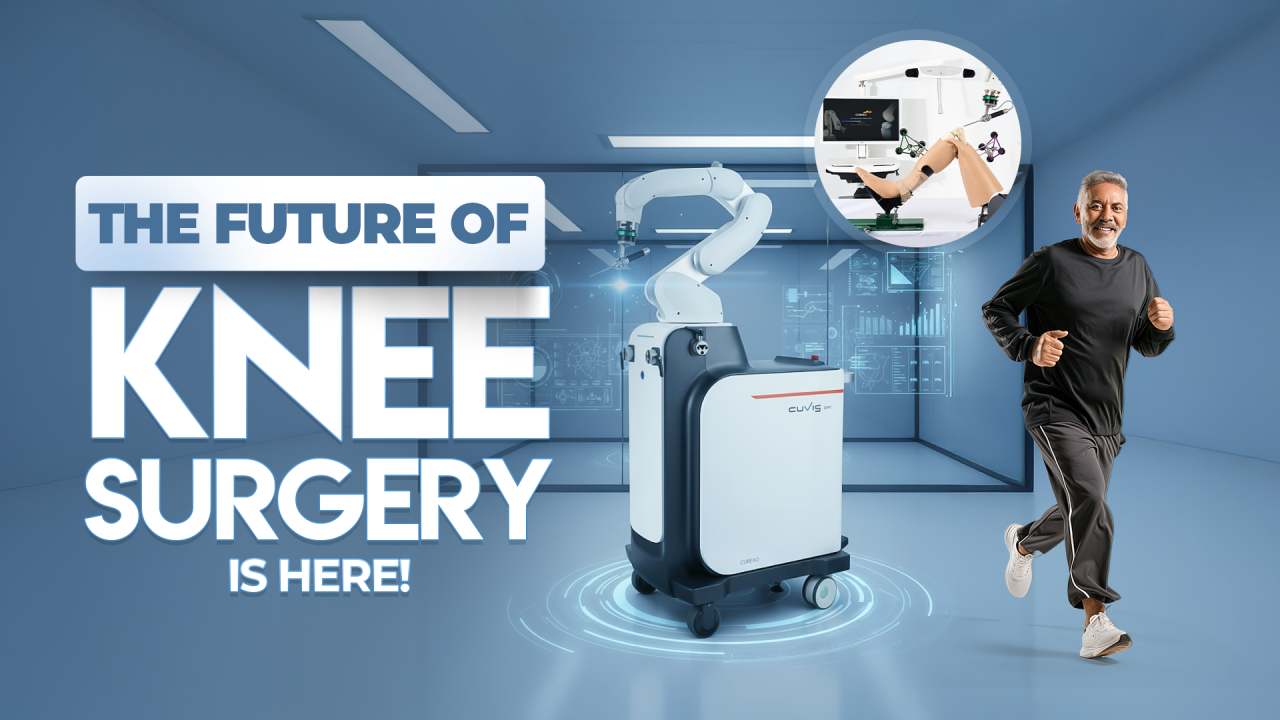The Precision Revolution: How Kailash Hospital is Transforming Knee Surgery with Robotic Expertise
Verified By Dr. Anuj Jain | 01-Oct-2025
In the realm of orthopedics, the journey from debilitating joint pain to restored mobility has long been a challenging one. Traditional knee replacement surgery, while highly successful, often involved a degree of estimation, manual skill, and a significant recovery period. However, a new era has dawned. At Kailash Hospital, Noida, we are pioneering a future where joint replacement is not just a procedure but a meticulously planned journey back to vitality, powered by automated AI robotics. This is the world of robotic knee replacement surgery, and it is redefining every aspect of patient care.
Under the leadership of renowned experts like Dr. Anuj Jain, Sr. Consultant Orthopedics at Kailash Hospital, the institution has cemented its position as a Centre of Excellence in Joint Replacement. Dr. Jain emphasizes, "Our goal has always been to achieve the best possible outcomes for our patients. With robotic technology, we are no longer relying solely on experience and feel; we are augmenting our skills with data-driven, sub-millimeter precision. This is a paradigm shift in how we approach knee surgery."
Table of Content
Contrary to popular belief, robotic knee surgery does not mean a robot performs the operation autonomously. Instead, think of the robotic system as a highly sophisticated, intelligent surgical assistant. The surgeon remains in complete control, but the robot provides an unprecedented level of accuracy and predictability.
The process begins long before the patient enters the operating theatre. As detailed in the hospital's approach, it starts with a CT scan of the patient's knee. This scan is converted into a detailed 3D virtual model of the patient’s unique anatomy. "This model is the blueprint for the entire procedure," explains Dr. Anuj Jain. "It allows us, as robotic knee replacement surgeons, to create a personalized surgical plan tailored to the patient's specific alignment, bone structure, and soft tissue balance. We decide on the exact size, position, and orientation of the implant in a virtual space first."
This pre-planning is what sets robotic knee replacement surgery apart. It transforms the procedure from a one-size-fits-all approach to a truly customized experience.
Also read: Knee Replacement Surgery: Expert Answers to Common Questions
1. Initial Consultation:
The journey begins with a comprehensive evaluation. The team at Kailash Hospital reviews the patient’s medical history and imaging studies. "This is a collaborative process," says Dr. Jain. "We discuss all potential treatment options. If a patient is a suitable candidate for robotic knee replacement surgery, we explain the technology and its significant benefits in detail."
2. CT Scanning and 3D Modeling:
The patient undergoes a quick, 10-minute CT scan. This scan is the foundation for creating the personalized 3D model, ensuring the surgical plan is based on the patient’s actual anatomy, not a statistical average.
3. Pre-Surgical Planning:
Using advanced software, the surgeon—be it Dr. Anuj Jain or another expert knee replacement surgeon on the team—meticulously plans the surgery on the digital twin of the patient's knee. This step ensures that the plan optimizes implant fit and alignment for stability and longevity.
4. Surgical Implementation: The Human-Robot Collaboration
In the operating room, the magic of synergy between surgeon and machine comes to life. The system’s optical tracking camera acts like a GPS, continuously monitoring the patient’s anatomy and the robotic arm’s movements.
"The robot’s arm, equipped with a milling tool, is guided by the surgeon," describes Dr. Anuj Jain. "But it operates within a predefined virtual boundary based on our surgical plan. This allows for bone preparation with incredible accuracy, protecting the surrounding healthy soft tissues. It’s this precision that leads to superior outcomes in robotic knee surgery."
5. Implant Placement:
The precisely prepared bone allows for the ideal placement of the implant. This correct alignment is critical for the feel and function of the new joint, aiming to mimic the natural kinematics of the knee as closely as possible.
The benefits of choosing a robotic knee replacement surgeon and a center of excellence like Kailash Hospital are profound and multi-faceted:
- Micro-Precision and Surgical Accuracy: The system offers near 100% accuracy in bone cuts and implant positioning, drastically reducing the potential for human error and improving the overall function of the new joint.
- Minimally Invasive Approach: Robotic knee surgery is inherently less invasive. The enhanced precision means a smaller incision, less tissue damage, and minimal trauma to the muscles and ligaments surrounding the knee.
- Faster Recovery and Shorter Hospital Stay: With less trauma comes less pain. Patients often experience a quicker overall recovery time, require a shorter hospital stay, and can begin physiotherapy sooner.
- Reduced Risk of Complications: Precision directly translates to safety. There is a lower risk of infection, significantly less blood loss, and a dramatically reduced need for blood transfusions. The accuracy also lowers the long-term risk of implant loosening or wear, potentially reducing the need for revision surgery.
- Natural Feel and Improved Outcomes: By preserving healthy tissue and optimizing implant alignment, patients frequently report that their new knee feels more natural and stable than those who underwent traditional knee replacement surgery.
A key concern for any patient considering knee surgery is the recovery process. The timeline at Kailash Hospital demonstrates the tangible benefits of the robotic approach:
- Day 1 After Surgery: Most patients are encouraged to take a few steps with assistance, a testament to the stability achieved during surgery.
- Day 2 After Surgery: Light physiotherapy and exercises begin in the hospital to promote healing and restore movement.
- 1 Week After Surgery: Formal physiotherapy sessions are crucial at this stage, significantly reducing pain and increasing mobility faster than traditional methods.
- 1 Month After Surgery: Patients typically notice a substantial improvement in daily function and activity levels, with most resuming normal activities within 2-3 months.
This accelerated timeline is a direct result of the precision inherent in robotic knee replacement surgery.
Also read: Robotic Knee Replacement: The Next Generation in Knee Surgery
At Kailash Hospital, the adoption of robotic technology is more than just an upgrade in equipment; it is a fundamental part of our philosophy of compassionate, patient-centric care. "Technology is a powerful tool, but it is the human touch that completes the healing process," affirms Dr. Anuj Jain. "Our dedicated team ensures that every patient feels supported, informed, and comfortable from the first consultation through to full recovery. The robot enhances our capability to deliver on our promise of exceptional care."
We believe in pioneering a compassionate approach to care. With robotics, we’ve redefined the possibilities of joint replacement treatment, prioritizing your well-being at every single step.
If you are considering knee replacement surgery, it is essential to consult with a surgeon who is trained in the latest technologies. Dr. Anuj Jain, Sr. Consultant Orthopedics, and the entire team at Kailash Hospital, Noida, are leaders in the field of robotic knee replacement surgery.
Discover the advantage of Robotic Joint Replacement—an innovative blend of precision, comfort, and exceptional outcomes. Trust us to guide you through a seamless journey towards improved health and vitality.
Take the first step towards a life without limitations. Contact Kailash Hospital today to schedule a consultation with our expert team.



 +91-9711918451
+91-9711918451
 international.marketing@kailashhealthcare.com
international.marketing@kailashhealthcare.com







